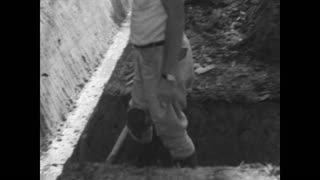Made in 1947 by the Pan American Union, “The Story of Bananas” describes the process of cultivating and harvesting bananas in Central America, upper South America, and the West Indies. It covers the entire journey from soil testing and clearing tropical forests to planting banana trees, maintaining plantations, and finally harvesting and transporting bananas to the United States. The text also highlights the roles of modern technology, such as radio and refrigerated ships, in ensuring the timely delivery of bananas. Additionally, it touches on the various uses of bananas in different dishes and their significance as a gift from the Americas to the world.
0:31 – 0:38: Bananas are cultivated in Central America, upper South America, and the West Indies.
0:42 – 0:57: Transforming tropical forests into banana plantations requires engineers and agricultural experts.
1:00 – 1:29: Soil tests are conducted to determine suitable areas for banana cultivation.
1:46 – 2:05: Workers use machetes to clear tropical undergrowth for planting.
2:09 – 2:40: Proper drainage is essential, with modern machinery used to dig drainage ditches.
3:04 – 3:28: Skilled laborers line and stake the planting area, placing stakes 14 feet apart.
3:56 – 4:12: Banana trees are planted at the foot of each stake, using root stocks called “romes.”
4:16 – 5:11: Planting involves placing the romes in 14-inch deep holes in soft, loamy soil.
5:50 – 6:28: Large trees are felled to make way for banana plants, which will bear fruit in about a year.
6:36 – 7:04: Secondary drainage ditches and levies are maintained to prevent flood damage.
7:11 – 7:32: Banana plants grow quickly, but require periodic cleaning to prevent weed overgrowth.
7:34 – 8:42: The banana plant’s structure is described, with the fruit-bearing stem growing through the center.
9:24 – 9:31: At 12 months, bananas point outward and upward until fully grown.
9:36 – 10:02: Modern radio and refrigerated ships play a crucial role in the banana industry, ensuring timely delivery to the U.S.
10:06 – 10:28: Cutting orders are relayed to plantations, and mules transport bananas to tram cars.
10:39 – 11:09: Mules carry bananas to the tram car receiving station.
11:11 – 12:03: A typical cutting crew consists of a cutter, a backer, and a mule man.
12:32 – 13:26: The cutter nicks the trunk, and the backer receives the bananas, which are then fastened to the mule.
13:51 – 14:13: Bananas are transported to the tram car receiving station and loaded for their journey.
14:25 – 15:05: Bananas are inspected and loaded into padded railroad cars for shipment.
15:08 – 15:36: Trains transport bananas through plantations to the port.
15:49 – 16:06: Banana boats are loaded with 45,000 stems of bananas for export.
16:09 – 16:32: Bananas are inspected and loaded onto ships using conveyor belts.
16:54 – 17:19: Ships maintain proper temperature during transit to the U.S.
17:34 – 18:24: Bananas are unloaded, inspected, and classified at the U.S. port.
18:35 – 19:04: Bananas are transported in refrigerated cars to different parts of the country.
19:09 – 19:50: Bananas are used in various dishes, including banana nut bread and banana salads.
19:53 – 19:55: The text concludes by highlighting bananas as a great gift from the Americas to the world.
Motion picture films don’t last forever; many have already been lost or destroyed. For almost two decades, we’ve worked to collect, scan and preserve the world as it was captured on 35mm, 16mm and 8mm movies — including home movies, industrial films, and other non-fiction. If you have endangered films you’d like to have scanned, or wish to donate celluloid to Periscope Film so that we can share them with the world, we’d love to hear from you. Contact us via the weblink below.
This film is part of the Periscope Film LLC archive, one of the largest historic military, transportation, and aviation stock footage collections in the USA. Entirely film backed, this material is available for licensing in 24p HD, 2k and 4k. For more information visit http://www.PeriscopeFilm.com


